1 问题要求及任务描述
1.1 题目要求
1.2 主要任务
2 解决问题的主要思路和方法
2.1 关键问题
输出数据:排序内容到文件,排序所用时间
2.2 拟采用解决问题的方法
把程序分为多个模块,有的是排序的算法如:void InsertSort(int a[],int p)
下面是所用排序法的算法思想:
(6)堆排序基本思想是:堆是n个元素的序列,先建堆,即先选得一个关键字最大或最小的记录,然后与序列中
2.3 主要算法和处理流程图
3 程序实现
3.1 程序实现时应考虑的问题
模块化能使节约资源,也方便了程序的调试和
3.2 主要源代码及说明
#include
#include
#include
#include
#include
#define N 30000
void Wrong()
{
printf("\n=====>按键错误!\n");
getchar();
}
void Disp(int a[])
{
int i;
system("cls");
for(i=0;i
{
if((i-1)%10==9)
printf("\n");
printf("%-7d",a[i]);
}
}
void InsertSort(int a[],int p) //插入排序
{
int i,j,temp;
for(i=1;i
{
temp=a[i];
for(j=i;j>0&&a[j-1]>temp;j--)
a[j]=a[j-1];
a[j]=temp;
}
}
void SelectSort(int a[],int p) //选择排序
{
int i,j,k;
for(i=0;i
{
k=i;
for(j=i+1;j
k=j;
if(k!=i)
{
int temp;
temp=a[k];
a[k]=a[i];
a[i]=temp;
}
}
}
void BubbleSort(int a[],int p) /*冒泡排序算法*/
{
int i,j,temp;
for (i=0;i
{
for (j=N-1;j>i;j--) /*比较,找出本趟最小关键字的记录*/
{
temp=a[j]; /*进行交换,将最小关键字记录前移*/
a[j]=a[j-1];
a[j-1]=temp;
}
}
}
void creatheap(int a[],int i,int n) //创建堆
{
int j;
int t;
t=a[i];
j=2*(i+1)-1;
while(j<=n)
{
j++;
{
a[i]=a[j];
i=j;
j=2*(i+1)-1;
}
else
j=n+1;
}
a[i]=t;
}
void heapsort(int a[],int n,int p) //堆排序
{
int i;
int t;
for(i=n/2-1;i>=0;i--)
creatheap(a,i,n-1);
for(i=n-1;i>=1;i--)
{
t=a[0];
a[0]=a[i];
a[i]=t;
creatheap(a,0,i-1);}
}
void quicksort(int a[],int n,int p)
{
int i,j,low,high,temp,top=-1;
struct node
{
int low,high;
}st[N];
top++;
st[top].low=0;st[top].high=n-1;
while(top>-1)
{ low=st[top].low;high=st[top].high;
top--;
i=low;j=high;
if(low
{ temp=a[low];
while(i!=j)
{ while(itemp)j--;
if(i
while(i
if(i
}
a[i]=temp;
top++;st[top].low=low;st[top].high=
top++;st[top].low=i+1;st[top].high=
}
}
}
double TInsertSort(int a[],int p)
{
int i;
int b[N];
for(i=0;i
b[i]=a[i];
LARGE_INTEGER m_liPerfFreq={0};
QueryPerformanceFrequency(&m_liPerfFreq);
LARGE_INTEGER m_liPerfStart={0};
QueryPerformanceCounter(&m_liPerfStart);
InsertSort(b,p);
LARGE_INTEGER liPerfNow={0};
QueryPerformanceCounter(&liPerfNow);
double time=liPerfNow.QuadPart - m_liPerfStart
time/=m_liPerfFreq.QuadPart;
if(p!=6)
{Disp(b);getchar();}
printf("\n用直接插入排序法用的时间为%f秒;",time);
FILE *fp;
fp=fopen("直接插入排序.txt","w");
for(i=0;i
fprintf(fp,"%d ",b[i]);
fclose(fp);
return(time);
}
double TSelectSort(int a[],int p)
{
int i;
int b[N];
for(i=0;i
b[i]=a[i];
LARGE_INTEGER m_liPerfFreq={0};
QueryPerformanceFrequency(&m_liPerfFreq);
LARGE_INTEGER m_liPerfStart={0};
QueryPerformanceCounter(&m_liPerfStart);
SelectSort(b,p);
if(p!=6)
{Disp(b);getchar();}
LARGE_INTEGER liPerfNow={0};
QueryPerformanceCounter(&liPerfNow);
double time=liPerfNow.QuadPart - m_liPerfStart
time/=m_liPerfFreq.QuadPart;
printf("\n用直接选择排序法用的时间为%f秒;",time);
FILE *fp;
fp=fopen("直接选择排序.txt","w");
for(i=0;i
fprintf(fp,"%d ",b[i]);
fclose(fp);return(time);
}
double TBubbleSort(int a[],int p)
{
int i;
int b[N];
for(i=0;i
b[i]=a[i];
LARGE_INTEGER m_liPerfFreq={0};
QueryPerformanceFrequency(&m_liPerfFreq);
LARGE_INTEGER m_liPerfStart={0};
QueryPerformanceCounter(&m_liPerfStart);
BubbleSort(b,p);
LARGE_INTEGER liPerfNow={0};
QueryPerformanceCounter(&liPerfNow);
double time=liPerfNow.QuadPart - m_liPerfStart
time/=m_liPerfFreq.QuadPart;
if(p!=6)
{Disp(b);getchar();}
printf("\n用冒泡排序法用的时间为%f秒;",time);
FILE *fp;
fp=fopen("冒泡排序.txt","w");
for(i=0;i
fprintf(fp,"%d ",b[i]);
fclose(fp);return(time);
}
double Theapsort(int a[],int n,int p)
{
int i;
int b[N];
for(i=0;i
b[i]=a[i];
LARGE_INTEGER m_liPerfFreq={0};
QueryPerformanceFrequency(&m_liPerfFreq);
LARGE_INTEGER m_liPerfStart={0};
QueryPerformanceCounter(&m_liPerfStart);
heapsort(b,N,p);
LARGE_INTEGER liPerfNow={0};
QueryPerformanceCounter(&liPerfNow);
double time=liPerfNow.QuadPart - m_liPerfStart
time/=m_liPerfFreq.QuadPart;
if(p!=6)
{Disp(b);getchar();}
printf("\n用堆排序法用的时间为%f秒;",time);
FILE *fp;
fp=fopen("堆排序.txt","w");
for(i=0;i
fprintf(fp,"%d ",b[i]);
fclose(fp);return(time);
}
double Tquicksort(int a[],int n,int p)
{
int i;
int b[N];
for(i=0;i
b[i]=a[i];
LARGE_INTEGER m_liPerfFreq={0};
QueryPerformanceFrequency(&m_liPerfFreq);
LARGE_INTEGER m_liPerfStart={0};
QueryPerformanceCounter(&m_liPerfStart);
quicksort(b,N,p);
LARGE_INTEGER liPerfNow={0};
QueryPerformanceCounter(&liPerfNow);
double time=liPerfNow.QuadPart - m_liPerfStart
time/=m_liPerfFreq.QuadPart;
if(p!=6)
{Disp(b);getchar(); }
printf("\n用快速排序法用的时间为%f秒;",time);
FILE *fp;fp=fopen("快速排序.txt","w");
for(i=0;i
fprintf(fp,"%d ",b[i]);
fclose(fp); return(time);
}
void BubleSort(double a[]) //时间数组的冒泡排序
{
int i,j;
double temp;
for(i=1;i<6;i++)
{
for(j=4;j>=i;j--)
{
temp=a[j+1];
a[j+1]=a[j];
a[j]=temp;
}
}
}
void menu()
{
printf(" ★☆
printf(" ☆★*******************************
printf("\n====>请在上述序号中选择一个并输入:");
}
void main()
{
int i,p,a[N];
srand((int)time(NULL)); /*随机种子*/
for(i=0;i
a[i]=rand()%50000+1;
while(1)
{
system("cls");
menu();
scanf("%d",&p);
if(p==0)
{
printf("=====>谢谢使用!\n");
getchar();
break;
}
double TIMES[5],TIMES1[5];//时间数组
switch(p)
{
case 1:TInsertSort(a,p);printf("\n请按任意键继续...");
case 2:TSelectSort(a,p);printf("\n请按任意键继续...");
case 3:TBubbleSort(a,p);printf("\n请按任意键继续...");
case 4:Tquicksort(a,N,p);printf("\n请按任意键继续...")
case 5:Theapsort(a,N,p);printf("\n请按任意键继续...");
case 6:system("cls");
TIMES1[1]=TIMES[1]=TInsertSort(a,p);TIMES1[2]=TIME
TIMES1[3]=TIMES[3]=TBubbleSort(a,p);TIMES1[4]=
BubleSort(TIMES);
printf("\n\n");
{
printf("排序这组数据两种较快的排序法分别是:\n");
if(TIMES[1]==TIMES1[1]) printf("直接插入排序:%f秒!\n",
if(TIMES[1]==TIMES1[2]) printf("直接选择排序:%f
if(TIMES[1]==TIMES1[3]) printf("冒泡排序:%f秒!\n",TI
if(TIMES[1]==TIMES1[4]) printf("快速排序:%f秒!\n",TI
if(TIMES[1]==TIMES1[5]) printf("堆排序:%f秒!\n",TIM
if(TIMES[1]!=TIMES[2])
{
if(TIMES[2]==TIMES1[1]) printf("直接插入排序:%f
if(TIMES[2]==TIMES1[2]) printf("直接选择排序%f秒
if(TIMES[2]==TIMES1[3]) printf("冒泡排序%f秒!\n",TIM
if(TIMES[2]==TIMES1[4]) printf("快速排序%f秒!\n",TIM
if(TIMES[2]==TIMES1[5]) printf("堆排序%f秒!\n",TIME
}
} printf("\n请按任意键继续...");srand((int)time(NULL));
for(i=0;i
case 7:Disp(a);FILE *fp;fp=fopen("随机数.txt","w");
for(i=0;i
default:Wrong();printf("\n请按任意键继续...");getchar();b
}
}
}
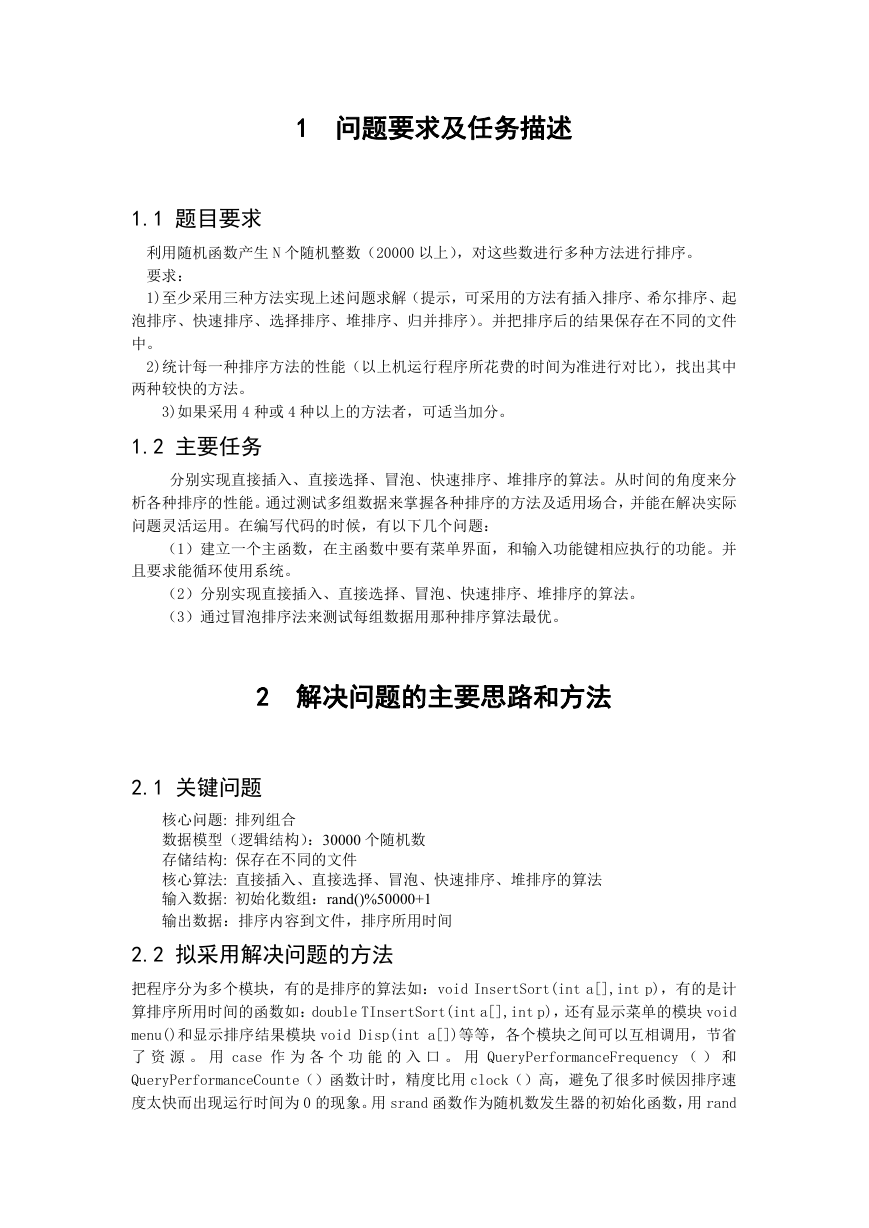
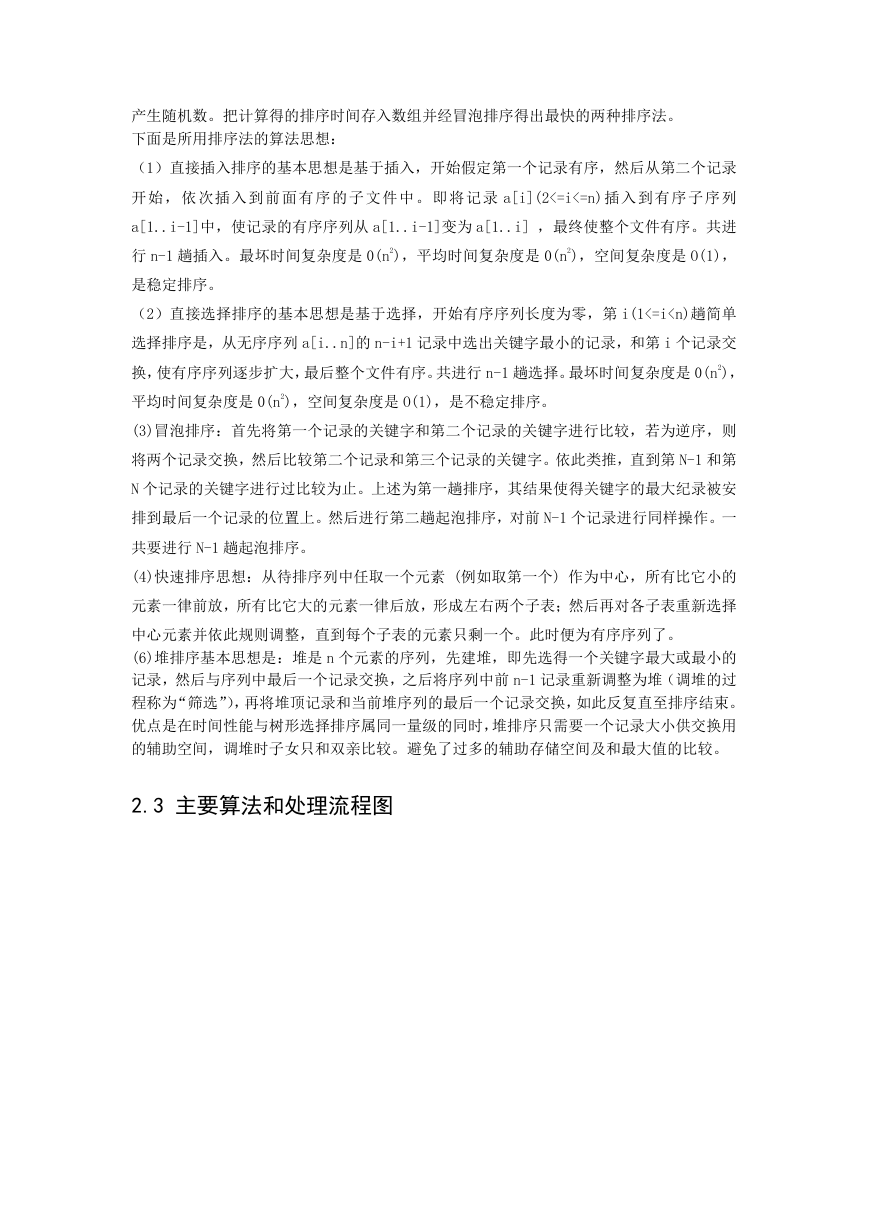

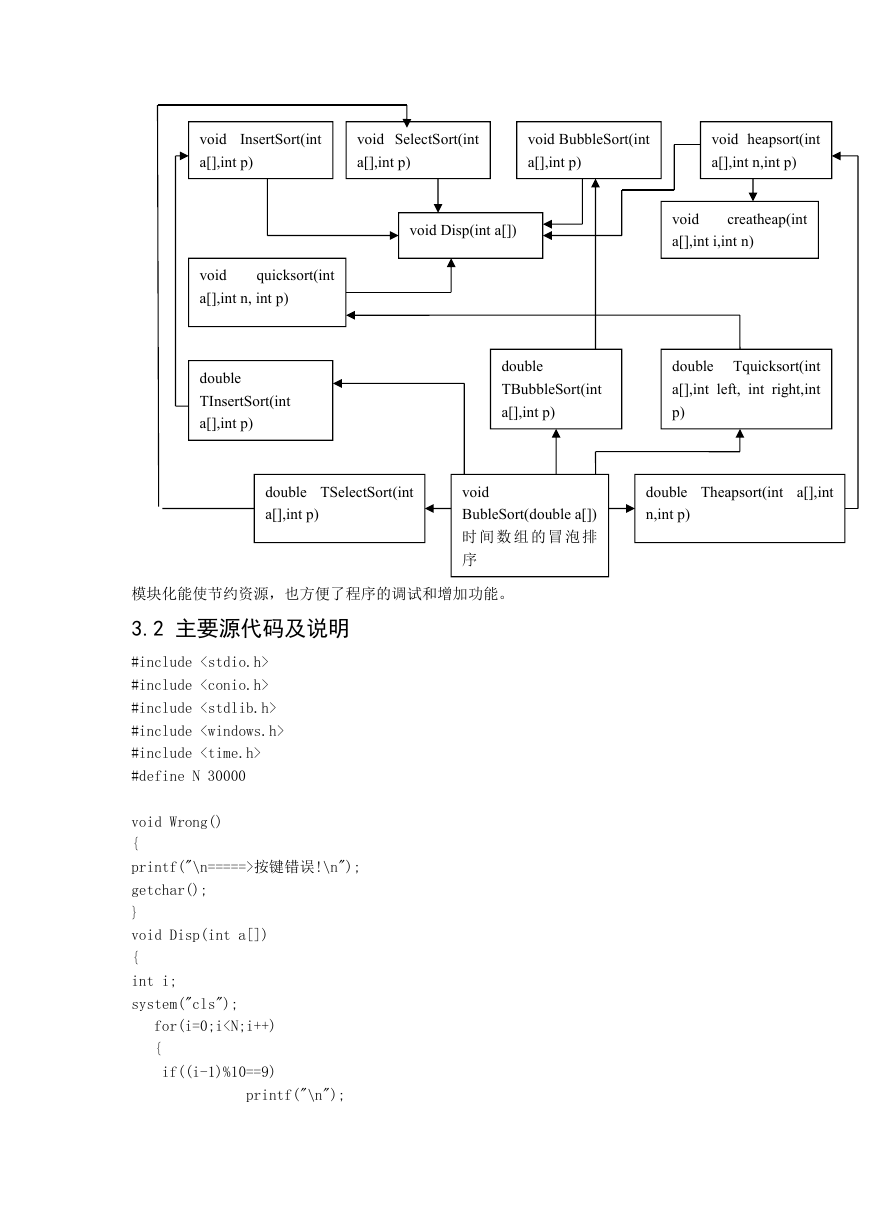
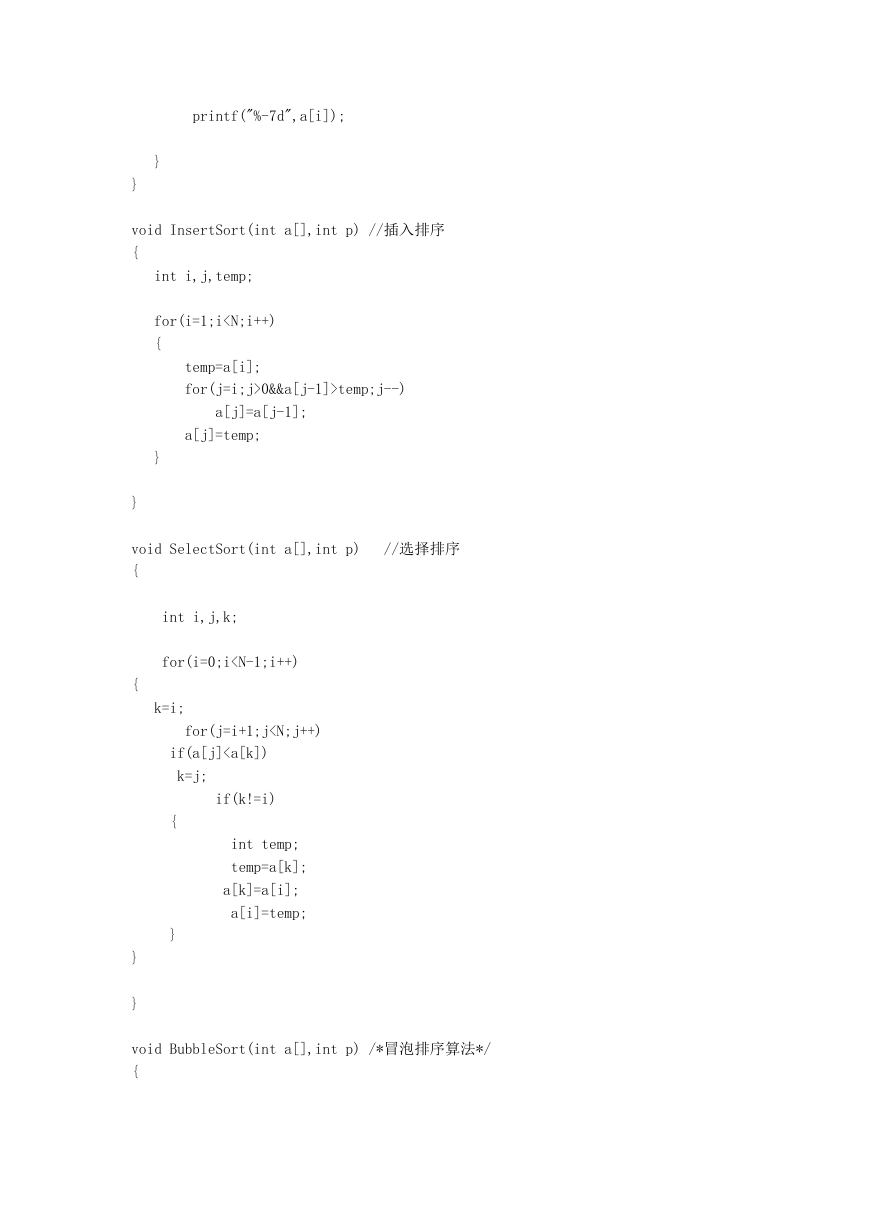
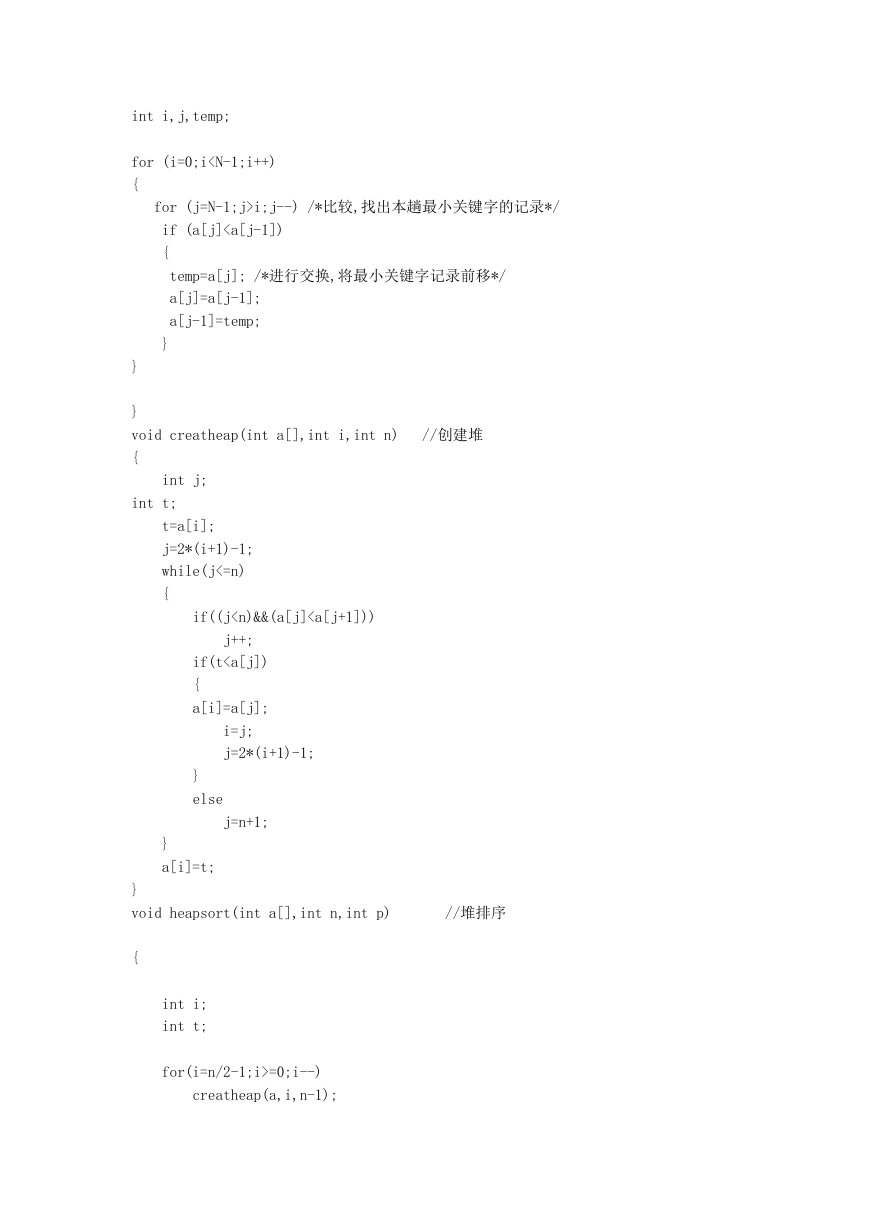










 2023年江西萍乡中考道德与法治真题及答案.doc
2023年江西萍乡中考道德与法治真题及答案.doc 2012年重庆南川中考生物真题及答案.doc
2012年重庆南川中考生物真题及答案.doc 2013年江西师范大学地理学综合及文艺理论基础考研真题.doc
2013年江西师范大学地理学综合及文艺理论基础考研真题.doc 2020年四川甘孜小升初语文真题及答案I卷.doc
2020年四川甘孜小升初语文真题及答案I卷.doc 2020年注册岩土工程师专业基础考试真题及答案.doc
2020年注册岩土工程师专业基础考试真题及答案.doc 2023-2024学年福建省厦门市九年级上学期数学月考试题及答案.doc
2023-2024学年福建省厦门市九年级上学期数学月考试题及答案.doc 2021-2022学年辽宁省沈阳市大东区九年级上学期语文期末试题及答案.doc
2021-2022学年辽宁省沈阳市大东区九年级上学期语文期末试题及答案.doc 2022-2023学年北京东城区初三第一学期物理期末试卷及答案.doc
2022-2023学年北京东城区初三第一学期物理期末试卷及答案.doc 2018上半年江西教师资格初中地理学科知识与教学能力真题及答案.doc
2018上半年江西教师资格初中地理学科知识与教学能力真题及答案.doc 2012年河北国家公务员申论考试真题及答案-省级.doc
2012年河北国家公务员申论考试真题及答案-省级.doc 2020-2021学年江苏省扬州市江都区邵樊片九年级上学期数学第一次质量检测试题及答案.doc
2020-2021学年江苏省扬州市江都区邵樊片九年级上学期数学第一次质量检测试题及答案.doc 2022下半年黑龙江教师资格证中学综合素质真题及答案.doc
2022下半年黑龙江教师资格证中学综合素质真题及答案.doc